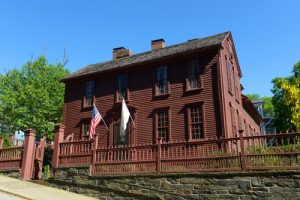The Stephen Hopkins House
If you’re planning to visit Providence, Rhode Island soon then you should consider going to the Stephen Hopkins House. It is named after Stephen Hopkins, who is the most popular colonial resident of the city. The house is also the oldest residential building in Providence and is very rich in history. Hopkins is one of the men who signed the Declaration of Independence. He also played many important roles in the history of Rhode Island. He became Chief Justice of the state’s Supreme Court.
He also served as Chancellor of Brown University. He was also a ten-time governor of the colony and was a delegate to the Colonial and Continental Congresses. Hopkins is indeed a very important man. Anyone who wants to learn more about the history of the U.S. needs to get to know him more. And the best way to do so is to visit the place that he called home when he was still alive. Here in this article, you’ll find important information that you’ll need if you’re planning to visit the Stephen Hopkins House. 
Providence owes a lot to Hopkins. He helped the city to develop its economy and infrastructure. The Stephen Hopkins House was his actual place of residence from 1743 to 1785, the year he passed away. It was just a small house when he bought it but he later expanded it to become what it is today. He was nearly 70 during the time of the Continental Congress. Hopkins was said to be suffering from what was most likely Parkinson’s Disease. He had tremors. When he signed the declaration of independence he reportedly uttered: “My hand trembles, my heart does not.”
George Washington actually spent a night at the Hopkins home on April 5, 1776, but Hopkins himself was not there during that time. This is because he was at the Continental Congress. Washington was entertained by Hopkins’ daughter-in-law. There was actually an interesting story that happened during the great general’s visit. It was said that some of Hopkins’ relatives wanted to use the best china in serving Washington. The daughter-in-law disagreed however and said that was good enough for her father should also be good enough for Washington. If you visit the Stephen Hopkins House, you’ll be able to go to the bedroom where George Washington slept during his visit.
One of the things that you need to know about the Stephen Hopkins House is that it is not a big house. But one of the things that you’ll notice is that the objects inside are well displayed. The objects on display are truly representative of the time period. It also tells how the inhabitants of the house lived during that time and their involvement in what was happening in the political scene.
So how you will appreciate the objects will depend largely on your interest and knowledge. Unlike other museums, there are no roped or gated sections in the house. You can access all of the rooms. So you really feel like you’re entering a house and not a museum. There’s a feeling that the owners of the house have just left for a while. This provides a feeling that is hard to get with other museums.
The house has a total of eight rooms and it’s full of antiques and heirlooms. Apart from the room where George Washington slept, you’ll also see a slaves’ room. Another important part of the house is the gallery that displays a collection of 18th-century samplers. The outside portion of the house is also interesting. It has a beautiful garden designed by Alden Hopkins of Williamsburg. A walk through this garden is definitely worth it. But the garden is at its best during springtime when the flowers are in full bloom.
Stephen Hopkins House is open all year round on Wednesdays from 11:00 am to 2:00 pm. It’s also open on Saturdays from April to November from 10:00 am to 4:00 pm. Guided tours of the house are also available. You should also stay for the WaterFire lightings. It’s located on Benefit Street between the John Brown House and Roger Williams’ First Baptist Church. It’s also located just a block away from the RISD Museum, Brown University, and the Athenaeum.

